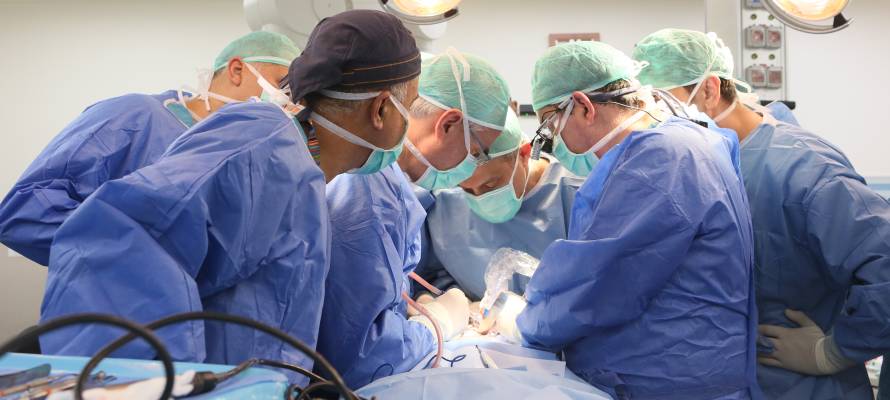A new model of treatment, called “Bring the Patient, Bring the Surgeon,” not only benefits the patient, but also helps educate physicians across borders.
A young girl from the Palestinian Authority (PA)-run city of Nablus (Shechem) in Samaria was diagnosed and treated through an international collaboration that involved Israel’s Rambam Health Care Campus, the PA and the United States National Institutes of Health (NIH). A new model of treatment, called “Bring the Patient, Bring the Surgeon,” has secured Jummana’s ongoing care as well as successful treatment of others suffering from her rare condition.
Last week, Jummana successfully underwent necessary but complex surgery, considering her young age and the specialized follow-up care required. She had been suffering from a serious endocrine problem. Her physicians in the PA initially referred her to Rambam.
She arrived at Rambam wheelchair-bound because of extreme bone pain due to severe hypophosphatemia (extremely low phosphate levels). The cause of her condition had left her physicians puzzled.
After examining her, endocrinologist, Professor Dov Tiosano, Director of Pediatric Endocrinology in Rambam’s Ruth Rappaport Children’s Hospital, understood that they were dealing with hormone FGF23, which is secreted from the bones.”
Doctors have only become aware of FGF23 in the past decade. Usually over-secretion of FGF23 is related to genetic disease—not unlikely since Jummana’s parents were first cousins. However, testing revealed no genetic problems. Professor Tiosano explained there was only one other possible cause: a tumor. Convinced that a tumor had to be there, he contacted a colleague in the NIH. The diagnosis was finally made: a rare tumor only half a centimeter in size, in the palette, was consuming massive amounts of calcium and phosphorous from Jummana’s bones. Rare in adults, such a tumor was unheard of in a teen.
Following the diagnosis, the NIH turned to experts for advice regarding the best qualified hospitals to perform the complicated surgery. It came down to four choices. Professor van Aalst, director of Plastic Surgery at Cincinnati Children’s Hospital, explains, “Why did we choose Rambam? Because of all the connections here, it was simpler for the family, and in the end safest, because she had a major endocrine problem that would be quite complicated to treat once the tumor was removed.”
Jummana’s doctors in the PA were contacted. They in turn made a referral to Rambam via the PA Ministry of Health. While bureaucracy was being handled, Dr. Omri Emodi – deputy director of the Department of Oral and Maxillofacial Surgery at Rambam – set up the multidisciplinary team needed for Jummana’s surgery, which included bringing her doctors from Nablus to Rambam to observe the procedure and learn more about the condition.
Dr. John A. van Aalst, director of the Division of Plastic Surgery in Cincinnati Children’s Hospital flew in for the surgery as well. “Omri didn’t need me for the surgery, but I wanted to be there. I had a personal sense of responsibility. I said to Omri, you set the date and I’ll be there.”
None of this would have happened if it were not for the story within the story, van Aalst shared. His mother was born in Tulkarem, a Palestinian city near Netanya, just south of Haifa. With family throughout the Palestinian Authority-run territories of Judea and Samaria, he is deeply connected to his family and friends there and especially wants to contribute to their medical advancement.
For the last 10 years, van Aalst has been working together with two surgeons from the PA-ruled areas who happened to have been Jummana’s doctors. In addition, he is a friend of Emodi’s. “Every 6 months I have been going to the West Bank and Gaza to operate. At the end of my time there I visit Rambam to work with Omri. Three years ago I introduced the surgeons from the PA to Omri; this is now their third trip here to Rambam.”
“When we made the decision that Jummana was going to come to Rambam, we invited her Nablus physician to create the medical report; he became the driving force to get her here.” van Aalst said. Because the doctors knew each other and were known to the authorities involved, it was easy to make the arrangements for the PA doctors to come with Jummana.
Emodi and van Aaalst are strong proponents of this new model of medical care: Rather than bringing only the patient from the West Bank or Gaza, the patient’s surgeon and physician are brought as well.
Explaining the complexity of Jummana’s follow-up, Tiosano said, “Now that the tumor has been removed, we hope to be able to restore the calcium and the phosphate to her bones. Given that her bone density is extremely low, building her bones up again is the real challenge. This will be a long journey, but we are on track,” Tiosano said.
Furthermore, “There is a huge interest in Jummana’s recovery. Because of the rarity of the case, one of the NIH Rehabilitation experts will also be visiting during follow-up to see how she is doing and to learn how our intervention is helping her to return to normal bone density and function.”
Jummana will soon be released home to Nablus. She must still undergo follow-up at Rambam for her ongoing condition, but her hope for the future is much brighter due to the collaboration and goodwill of doctors who live and breathe their Hippocratic oath.
Source: Rambam Health Care Campus
